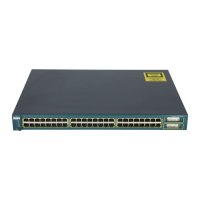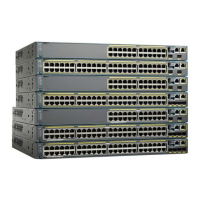82 Cisco LAN Switching Configuration Handbook
Core_switch (config-if)# frame-relay interface-dlci 110
Core_switch (config-if)# ip address 192.168.255.5 255.255.255.252
Core_switch (config-if)# no shutdown
Core_switch (config-if)# end
Core_switch # copy running-config startup-config
Core_switch # quit
An example of the Core_switch_2 configuration running IOS follows:
Core_switch_2>enable
Core_switch_2# config t
Core_switch_2(config)# interface serial 7/0/0
Core_switch_2(config-if)# encapsulation frame-relay
Core_switch_2(config)# interface serial 7/0/0.120
Core_switch_2(config-if)# frame-relay interface-dlci 120
Core_switch_2(config-if)# ip address 192.168.255.6 255.255.255.252
Core_switch_2(config-if)# no shutdown
Core_switch_2(config-if)# end
Core_switch_2# copy running-config startup-config
5-5: Layer 3 Virtual Interfaces
■ Virtual interfaces exist for configuration where there is no single physical attachment
to a broadcast domain.
■ For switches with Layer 2 interfaces, VLANs define broadcast domains.
■ The VLAN interface is a Layer 3 interface for any member of the given VLAN.
■ For switches or routers with Layer 3 interfaces, broadcast domains are defined as
bridge groups.
■ To route between bridge groups and other broadcast domains, a bridged virtual
interface (BVI) is used as a Layer 3 interface.
■ In some instances, a physical Layer 3 interface can support traffic from multiple
VLANs.
■ To provide Layer 3 interfaces for each VLAN on the physical connection, a subinter-
face is configured as the Layer 3 interface for the members of the VLAN.
Configuring a VLAN Interface
1. Configure a VLAN switched virtual interface (SVI):
(global) interface vlan number
In global configuration mode, use this command to create and access a VLAN inter-
face. This interface is in the same broadcast domain as the members of the VLAN
number. For this interface to be active, it must first exist in the VLAN database of
